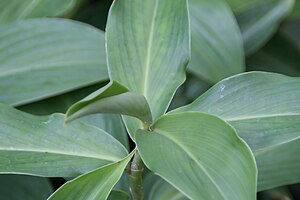Note: This is a project under development. The articles on this wiki are just being initiated and broadly incomplete. You can Help creating new pages.
Difference between revisions of "Curcuma zedoaria"
(→Common names) |
|||
| Line 11: | Line 11: | ||
==Common names== | ==Common names== | ||
| − | {{Common names|sa=|en=|gu=|hi=|kn=|ks=|ml=|mr=|pa=|ta=|te=}} | + | {{Common names|sa=Gandhamooli, Karchoora|en=Zeedore|gu=|hi=Kachuru, Kaalihaldi|kn=Kadu Arisina, Kachora|ks=|ml=Kachoori kilannu, Kuva|mr=|pa=|ta=Kichchili Kilangu|te=Kachoram}} |
==Properties== | ==Properties== | ||
Revision as of 18:10, 8 October 2021
Curcuma zeodaria is a herbaceous, perennial plant. Each pseudostem comprises around 5 leaves with blades around 35cm long and 13cm wide.
Contents
- 1 Uses
- 2 Parts Used
- 3 Chemical Composition
- 4 Common names
- 5 Properties
- 6 Habit
- 7 Identification
- 8 List of Ayurvedic medicine in which the herb is used
- 9 Where to get the saplings
- 10 Mode of Propagation
- 11 How to plant/cultivate
- 12 Commonly seen growing in areas
- 13 Photo Gallery
- 14 References
- 15 External Links
Uses
Indigestion, Nausea, Flatulence, Bloating, Cervical cancer, Bad breath, Ulcers, Wounds, Skin disorders.
Parts Used
Chemical Composition
Common names
| Language | Common name |
|---|---|
| Kannada | Kadu Arisina, Kachora |
| Hindi | Kachuru, Kaalihaldi |
| Malayalam | Kachoori kilannu, Kuva |
| Tamil | Kichchili Kilangu |
| Telugu | Kachoram |
| Marathi | |
| Gujarathi | |
| Punjabi | |
| Kashmiri | |
| Sanskrit | Gandhamooli, Karchoora |
| English | Zeedore |
Properties
Reference: Dravya - Substance, Rasa - Taste, Guna - Qualities, Veerya - Potency, Vipaka - Post-digesion effect, Karma - Pharmacological activity, Prabhava - Therepeutics.
Dravya
Rasa
Guna
Veerya
Vipaka
Karma
Prabhava
Habit
Identification
Leaf
| Kind | Shape | Feature |
|---|---|---|
Flower
| Type | Size | Color and composition | Stamen | More information |
|---|---|---|---|---|
| {{{5}}} |
Fruit
| Type | Size | Mass | Appearance | Seeds | More information |
|---|---|---|---|---|---|
Other features
List of Ayurvedic medicine in which the herb is used
Where to get the saplings
Mode of Propagation
How to plant/cultivate
A plant of the hot, humid, lowland tropics, where it is found at elevations up to 900 metres.[3]
Commonly seen growing in areas
[[:Category:Herbs that are commonly seen in the region of |]], [[:Category:Herbs that are commonly seen in the region of |]], [[:Category:Herbs that are commonly seen in the region of |]], [[:Category:Herbs that are commonly seen in the region of |]], [[:Category:Herbs that are commonly seen in the region of |]].
Photo Gallery
References
External Links
- Ayurvedic Herbs known to be helpful to treat Indigestion
- Ayurvedic Herbs known to be helpful to treat Nausea
- Ayurvedic Herbs known to be helpful to treat Flatulence
- Ayurvedic Herbs known to be helpful to treat Bloating
- Ayurvedic Herbs known to be helpful to treat Cervical cancer
- Ayurvedic Herbs known to be helpful to treat Bad breath
- Ayurvedic Herbs known to be helpful to treat Ulcers
- Ayurvedic Herbs known to be helpful to treat Wounds
- Ayurvedic Herbs known to be helpful to treat Skin disorders
- Herbs with Rhizome used in medicine
- Herbs with common name in Kannada
- Herbs with common name in Hindi
- Herbs with common name in Malayalam
- Herbs with common name in Tamil
- Herbs with common name in Telugu
- Herbs with common name in Sanskrit
- Herbs with common name in English
- Habit - Perennial
- Index of Plants which can be propagated by Seeds
- Index of Plants which can be propagated by Division of rhizome
- Herbs that are commonly seen in the region of
- Herbs
- Pages without herbs images




